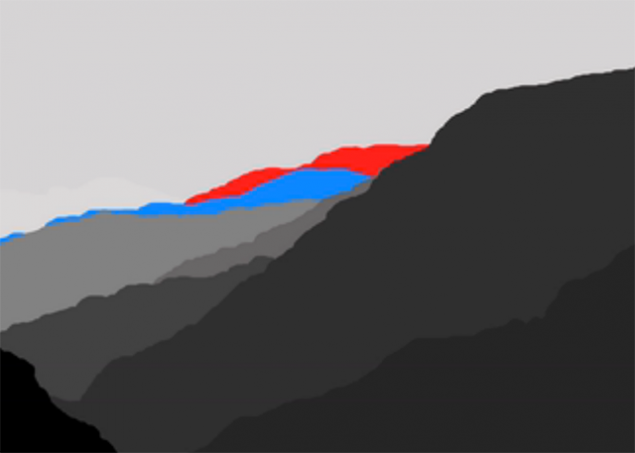604
"Mountain illusion": what's wrong with this picture?
Do not believe your eyes svoimVzglyanite on the photo below. Do you see anything unusual? Look better than the two mountains in the distance, and your vision will play with you a joke: the mountain peaks seem transparent.

The photograph was taken of a researcher Thomas Carlson during his visit to the Himalayas. And he was so intrigued by the effect that, together with his colleague Susan Wardle (Susan Wardle) wrote a research paper for the journal i-Perception about why this happens.

"We ended a long day's march, and I was exhausted. I went to his room when he saw the mountain for the first time "- he recalls. - "It was a spectacular view. Then I realized that observe transparent mountain that drew my attention, is simply impossible ».
Back in his laboratory in the Macquarie University in Sydney, Australia, he showed a picture of Susan Wardle.
"The feature that immediately caught my eye - besides the fact that it was a very beautiful picture - was that this illusion of a united several of the principles of visual perception", - she says.
A strange kind of part can be explained by the way the atmosphere scatters light, causing the remote mountains appear much paler, almost blending the color of the sky. But the illusion complements the fact that the two distant peaks seem to overlap, forming a dark area at the bottom. About the same two pieces of tinted glass will appear darker if you put them on each other.
Darker plot - is actually a separate top, and the picture presented below, clearly gives to understand.

However, our brain tends to connect the line the simplest possible way - the principle of "good continuation" - that is in our minds the illusion that we are looking at two glass mountain, superimposed on each other.
The principle of good continuation also explains why we are in this classic illusion of seeing two large overlapping triangles rather than piling up of lines and shapes.
"[Mount] just a great example of perceptual inferences that our brain does on a daily basis," - says Wardle. - "In real life, manages to pull off such a rare example, there need special lighting and a special angle that Tom saw the mountains, so it's a very lucky find».
via www.bbc.com/future/story/20150522-the-mountain-illusion-whats-wrong-with-this-picture?ocid=global_future_rss

The photograph was taken of a researcher Thomas Carlson during his visit to the Himalayas. And he was so intrigued by the effect that, together with his colleague Susan Wardle (Susan Wardle) wrote a research paper for the journal i-Perception about why this happens.

"We ended a long day's march, and I was exhausted. I went to his room when he saw the mountain for the first time "- he recalls. - "It was a spectacular view. Then I realized that observe transparent mountain that drew my attention, is simply impossible ».
Back in his laboratory in the Macquarie University in Sydney, Australia, he showed a picture of Susan Wardle.
"The feature that immediately caught my eye - besides the fact that it was a very beautiful picture - was that this illusion of a united several of the principles of visual perception", - she says.
A strange kind of part can be explained by the way the atmosphere scatters light, causing the remote mountains appear much paler, almost blending the color of the sky. But the illusion complements the fact that the two distant peaks seem to overlap, forming a dark area at the bottom. About the same two pieces of tinted glass will appear darker if you put them on each other.
Darker plot - is actually a separate top, and the picture presented below, clearly gives to understand.

However, our brain tends to connect the line the simplest possible way - the principle of "good continuation" - that is in our minds the illusion that we are looking at two glass mountain, superimposed on each other.
The principle of good continuation also explains why we are in this classic illusion of seeing two large overlapping triangles rather than piling up of lines and shapes.
"[Mount] just a great example of perceptual inferences that our brain does on a daily basis," - says Wardle. - "In real life, manages to pull off such a rare example, there need special lighting and a special angle that Tom saw the mountains, so it's a very lucky find».
via www.bbc.com/future/story/20150522-the-mountain-illusion-whats-wrong-with-this-picture?ocid=global_future_rss
























